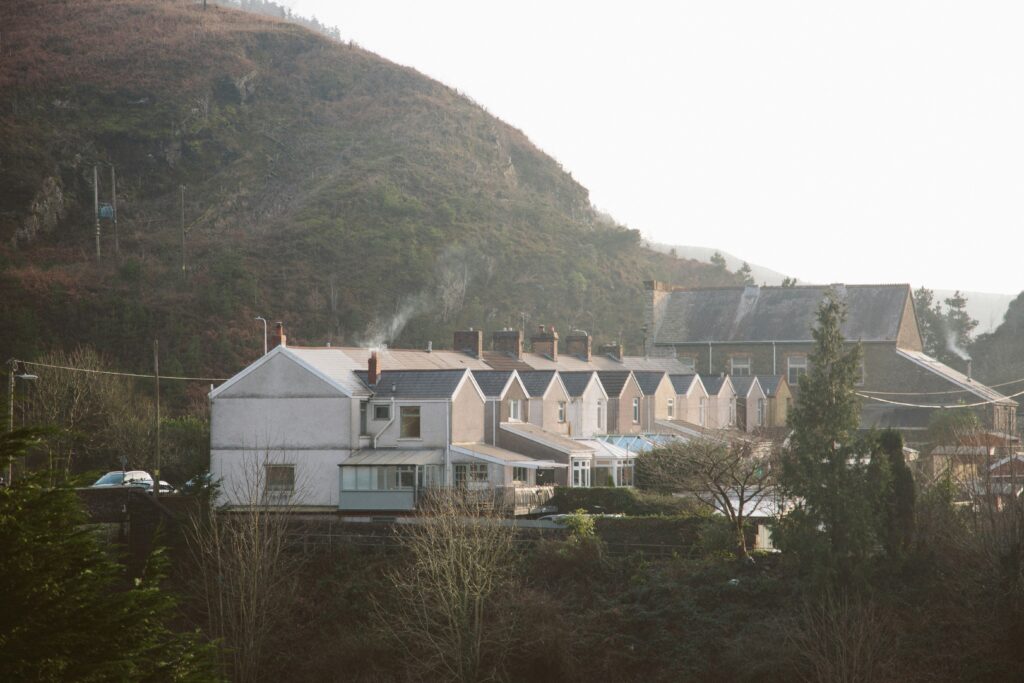Beau W Beakhouse depicts the musings of an unnamed narrator contemplating a transformed Welsh landscape in 2100.
I daydream in the unpredictable weather. Low grey clouds are approaching through the valley.
The clouds carry the promise of a hailstorm, and I shiver as they pass over without keeping it. Lingering plumes catch on the pinnacles of trees ascending the steep slopes. Then the sun is out, as though it had been for months, an indefatigable sun that all life in the valley reaches towards. I climb a track up the bulbous hillside, shadows of clouds rolling across the low vegetation. Cresting the hill, fields of hybrid banks absorb energy from the soil, from the wind, from the sun, stretching out across the plain, capping the coalescence of valleys and peaks with warped light absorption. As I walk through the fields, I can hear the subtle clicks and shifts in air pressure as they transmit their meteorological data elsewhere. Finding an open space beside the observatory, I lie back on the heathery ground, soaking up the sun, and behind closed eyes imagine myself floating through the valleys below me.
The houses feel like interchangeable containers, the markets like planned events, an algorithm of perfect city planning, maximised contentment and well-apportioned leisure.
⁂
From my prospect, I watch five beings in fluorescent orange suits mill around a common at the base of the hillside. Converging at the centre of the common, they scrape around in the long grass and uncover a large slab of metal. Sliding it aside they reveal a triangular hole, a shaft. They erect an 8-foot tripod over it. Then, from out of sight within the woods, two more beings in black rubberised suits, akin to scuba gear, fitted with harnesses and head torches, walk towards them. They exchange a few words, clip onto the tripod, and begin to descend, abseiling into the dark opening. Every 4 years, they inspect the culverts channelling water deep beneath the common and into the river that arcs through the valley. Following the echoing water, they inspect the tunnels for debris, blockage and structural weakness, the concrete passageways running above the deeper uncertainty of collapsing coal pillars in 300 year old mines. Looking down from the hillside on the surface of celandine and daisy and that triangular absence of light, I recall the solar eclipse of 2090. Tonight the supermoon is in Scorpio.
Robust debate and agenda-setting research.
Support Wales’ leading independent think tank.
⁂
Within the mist, the giant operating arms of the scrapyard pivot above mountains of recycled metal. The automated tools spin, balletic, above their chosen sea. Travelling through the valley at high speed, I only ever glimpse the scale of the metal yards between the trees; water vapour clinging to stonewashed paint. Overseen by operators elsewhere, the arms sort, process, move and load the metal into lorries that leave frequently on the main arteries of the valley. The front carriages of the train curve towards the hillside, the raised route ahead crossing roads and rivers, the curved glass windows creating a tube that reflects every flicker and change of light. A tunnel and then out and we bank right again, high above the valley; the corrugated roofs packed and overlapping, a legacy, a modified industry, running in sectors towards the sea.
⁂
When I’m in the city, I always walk along Commercial Road. It’s a cut through to the centre or, in the direction I’m walking now, to the river. Reading about past cities, weight was an unquestionable descriptor. But this street rests gently on the earth, impermanent, almost transparent. The implementation of a pipe, a transmitter, a façade, a transport link is swift and simple; peeling back a surface, unlocking a catch, registering a panel. Modularity has lended the city a lightness, a ghostly fabrication. The houses feel like interchangeable containers, the markets like planned events, an algorithm of perfect city planning, maximised contentment and well-apportioned leisure. At the end of the street, I look up at the Transporter Bridge. Strung across the river, suspending its carriage by many harmonious threads, its latticed boom reaches out above the water, girders rising from deep within the mud. In old photographs it is a symbol of industry, a giant H for history, its elliptical gridwork a pathway to its own fabrication at the disappeared steelworks. For the figures looking out from the decks of riverside apartments, surrounded by sunbathing equipment, on the foundations of the weathered brutalist flood defences, it remains a symbol, now because of its translucency and absence, a green and glowing leisure platform.
⁂
I let my hand touch the peaks of choppy water. Underneath is another world, swaying and silent, an alien logic that records the many voyages that have left this coast.
I look back at the hundreds of slipways along the coast, intermittently releasing passenger ferries into the water. My stomach turns over. On the cliff edges and further inland, stand rare grey pyramids, like rockets, planted into the rolling hills. We cut through the water, my friend guiding their sailboat towards the island. Gently rocking in the wind, I put my sunglasses on and stare at the horizon. Shades of green and blue; a beckoning band of turquoise hovering above the offing. I let my hand touch the peaks of choppy water. Underneath is another world, swaying and silent, an alien logic that records the many voyages that have left this coast. My friend calls me, they point towards the island, I can’t hear them over the wind but I watch them smiling. Ahead of us it slides out of the water, stained and rippled limestone, pockets of shingle shoreline and, grafted to the cliffs, a sharp sandy mass, the adjunct artificial island. More islands come into view, hopscotching out into the ocean. Islands of language, satellites, settlements; their opening festival. After we land, I wander along a promenade of stalls. I pause, watching someone carving the components of a chair. Their hands grip tightly, fusing with the waney timber. The air is bright and the wood golden and I stare into the movements of transformation, the effortless shaping of change.
This essay is part of a series commissioned in collaboration with the National Infrastructure for Wales.

All articles published on the welsh agenda are subject to IWA’s disclaimer. If you want to support our work tackling Wales’ key challenges, consider becoming a member.





